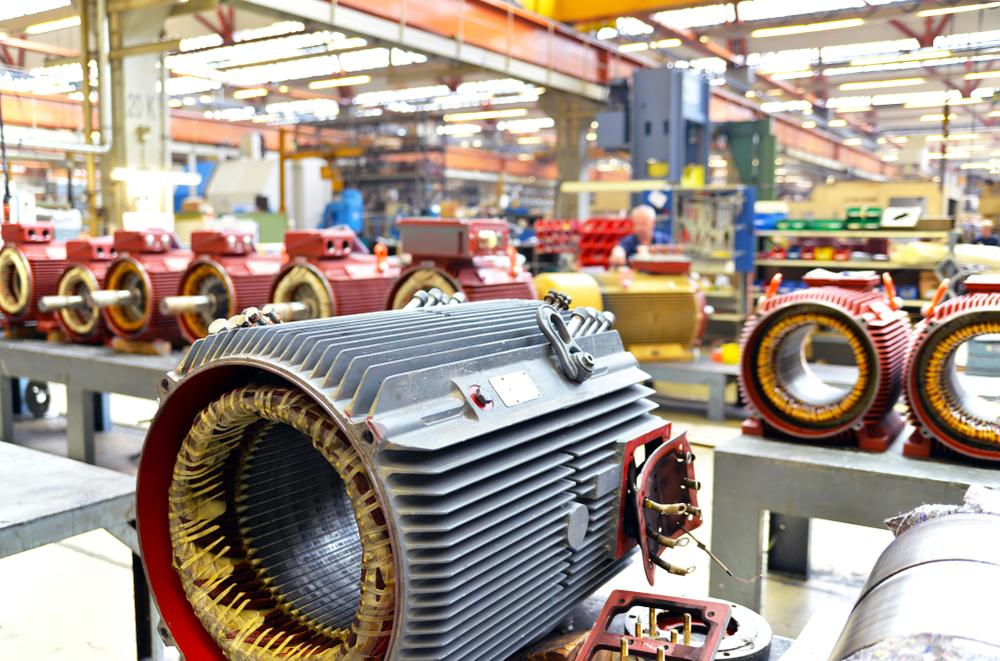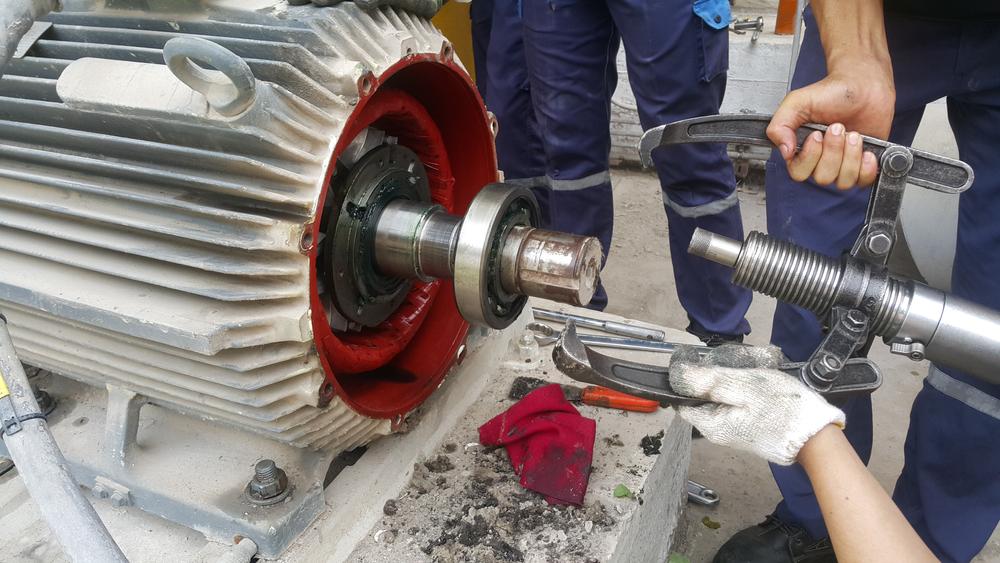Electric motors play a crucial role in any industrial facility. Electric motors power machinery and equipment, such as conveyor belts, pumps, fans, blowers, compressors, power tools, millers, movers, and more. While electric motors seem like workhorses that can continue to work forever, they have their limitations, just like any other mechanical component.
Luckily, most motors will give warning signs before they reach the point of catastrophic failure. Paying attention to these signs is critical to avoid complete motor failure, replacement costs, and downtime.
Electric Motor Terminology
Let’s briefly examine some basic electric motor terminology to understand our subject better:
Stator: The stationary part of the electric motor made of thin metal sheets called laminations. Electromagnetic energy is produced from the stator through either windings or permanent magnets.
Windings: Made from insulated metal wire, usually made of copper but occasionally from aluminum, windings are coiled around either the rotor or the stator. When energized, the windings form magnetic poles.
Rotor or Armature: Usually located in the center, the rotor is the main moving part of the motor. Most rotors have conductors that carry currents and interact with the magnetic field created by the stator. The alternating attraction and repulsion between the fields turn the rotor, which rotates the shaft and converts electrical energy into mechanical energy in the form of torque. Some manuals will refer to the rotor as the armature.
Shaft: The shaft spins with the rotor. It reaches out of the motor and takes electrical energy, turning it into mechanical energy.
Air Gap: This is a space left between the rotor and the stator specifically sized so that the magnetic fields interact.
Bearings: To keep things moving smoothly, bearings are located between the stator and the rotor. They keep the rotor centered and shrink the air gap. In smaller motors, ball bearings are used. In larger motors, roller bearings are used.
Fan: The fan is vital for keeping the motor cool during long operation periods.
6 Signs of Electric Motor Failure
Nearly 80 percent of electric motor failure is estimated to be preventable by paying attention to these warning signs. Proper motor maintenance can avert the vast majority of motor failures.
Watch out for these six signs of electric motor failure:
1. Overheating
Is your motor consistently overheating? Is it hot to the touch? Check the outside of the motor. Is the paint darkened in the middle? This is an indication of excessive heat. An increase of 18 degrees Fahrenheit or more, even for a short time, will damage the motor winding insulation and reduce its lifespan by half. This significantly impacts the lifespan of your motor.
The fan is the first thing to check if your motor is overheating. Make sure it moves freely, is clean and lubricated, and has no blockages or buildups of dirt or debris. Other potential causes of overheating could be a wrong voltage supply, poor power quality, a voltage imbalance, improper connections, or an overloaded motor.
If the motor is located at a high altitude, the fan may be insufficiently cooling it in the thinner atmosphere, causing it to overheat. Check the motor’s manual to find optimal operating conditions.
2. Vibration and Unusual Noises
Is your motor vibrating more than usual? One of the first warning signs of electric motor failure is the presence of unusual noises and vibrations. Vibrations can speed up the degradation of other components as they take on extra stress they were not designed to undergo and eventually lead to motor failure.
If you notice grinding, rattling, or humming sounds or the motor vibrating excessively, this is an indication that something is failing. Internal issues such as bearing wear, misalignment, or loose components are the usual culprits of vibration. Ball bearings receive the bulk of the wear and tear on a motor, and they are the component that will need to be replaced most often in a motor.
Other problems may be an insufficient load, shaft imbalance, shaft looseness, uneven mounting for the feet of the motor, unbalanced magnetic fields, missing balance weights, or an uneven mass in the motor windings.
3. Frequent Tripping of Circuit Breakers
If your electric motor frequently causes circuit breakers to trip or fuses to blow, there may be an underlying issue. This could be due to excessive current draw, short circuits, or motor winding problems. Ignoring these warning signs can lead to costly downtime and potential damage to other electrical components.
Regular maintenance, checking electrical connections, and conducting motor winding tests can help identify and resolve these issues before they worsen.
4. Decreased Performance and Efficiency
A decline in motor performance and efficiency is another warning sign of potential failure. If you notice a decrease in speed, power output, or overall performance, it could indicate internal damage or wear. This can result from worn-out bearings, misalignment, or deteriorating insulation.
Regular maintenance practices, including lubrication, alignment checks, and insulation resistance tests, can help identify and address these issues, ensuring optimal motor performance and efficiency. If lubrication is a consistent problem, consider using automatic lubrication.
5. Excessive Energy Consumption
Electric motors on the verge of failure often consume more energy than usual. If you notice a significant increase in energy consumption without any apparent reason, it could be a sign of impending motor failure.
Increased energy usage leads to higher operational costs and indicates underlying issues that need attention. Regularly monitoring energy consumption and conducting efficiency tests can help identify potential problems and optimize energy usage.
6. Irregular Motor Operation
Any irregularities in motor operation, such as sudden stops, intermittent operation, or failure to start, should not be ignored. These issues can stem from various causes, including electrical faults, mechanical problems, or control system malfunctions. Regular inspections, testing, and troubleshooting can help identify the root cause and prevent unexpected motor failure, minimizing downtime and production losses.
Operators should be trained not to repeatedly attempt to restart a motor that has failed to start. The start-up process significantly strains a motor and can cause components to overheat. Repeated startups, even under normal operation, can cause overheating. Repeated restarts can cause significant damage to a motor that might have been easily repaired. This is known as short cycling, a common cause of electric motor failure.

The Importance of Baseline Data for Maintaining Electric Motors
While there are warning signs of motor failure, by the time you physically notice these signs, it is often too late to save the critical components. Therefore, it is vital to record baseline data for your equipment. These metrics are crucial for allowing maintenance teams to identify potential problems so they can schedule preventative maintenance and minimize downtime.
We recommend recording the nameplate data for each piece of equipment in your maintenance plan. Be sure to get the serial number, as it usually indicates the month and year of manufacture, and attach a digital photo of the nameplate in case of recording errors or future nameplate damage.
Record the following operational baseline metrics:
Operating Conditions
Recording the operating conditions of electric motors is vital for understanding their performance. Key data points include ambient temperature, humidity levels, and voltage fluctuations.
Vibration Analysis
Vibration analysis provides valuable insights into the health of electric motors. Maintenance teams can detect abnormalities, such as misalignment or bearing wear, by measuring and recording vibration levels. Regular vibration analysis helps prevent catastrophic failures and allows for timely repairs.
Temperature Monitoring
Monitoring motor temperatures is crucial for preventing overheating, which can lead to motor failure. Baseline data points should include motor surface temperature, winding temperature, and cooling system performance. Deviations from normal temperature ranges can indicate issues with cooling or insulation, prompting necessary maintenance actions.
Power Consumption
Tracking power consumption data helps identify energy inefficiencies and potential motor problems. Record power consumption levels at various loads to form a baseline and monitor for significant deviations. Unexplained increases in power consumption may indicate issues like mechanical friction or electrical faults. Maintenance crews can use multi-meters to identify where electrical faults may be occurring.
Lubrication
Proper lubrication is essential for motor performance and longevity. Regularly analyzing lubricant samples can provide insights into the condition of bearings and other moving parts. Baseline data points for lubrication analysis include viscosity, contamination levels, and wear debris. Monitoring these factors helps determine optimal lubrication intervals and detect early signs of component wear.
By watching for sudden changes and fluctuations in these metrics, maintenance technicians can schedule repairs and maintenance procedures to protect valuable equipment.
IBT’s Customized Electric Motor Maintenance Solutions
Proper equipment maintenance is paramount in maintaining efficiency, especially for electric motors. Recognizing the warning signs of motor failure and implementing regular maintenance practices can save businesses from costly repairs, downtime, and potential safety hazards. By addressing issues promptly, companies can extend the lifespan of their electric motors, optimize performance and efficiency, and ensure uninterrupted operations.
IBT has over 70 years of facility maintenance experience. We can supply the diagnostics needed to analyze machine dynamics and performance while optimizing your maintenance procedures and scheduling. Our facility maintenance assessment services will save you time, money, and stress by helping you develop your own maintenance schedule for your maintenance crew to follow.
Do you need a maintenance crew? IBT offers Industrial Maintenance services that will optimize your critical production and support services. Our experienced team will take over your equipment’s maintenance. IBT’s professionals will ensure your equipment is operating at top efficiency. Our expertise in analyzing and maintaining equipment makes us a trusted partner in troubleshooting mechanical problems and identifying the root cause of motor issues.
Contact us today for more information about IBT’s Facility Maintenance Division services and how they can impact your business.





